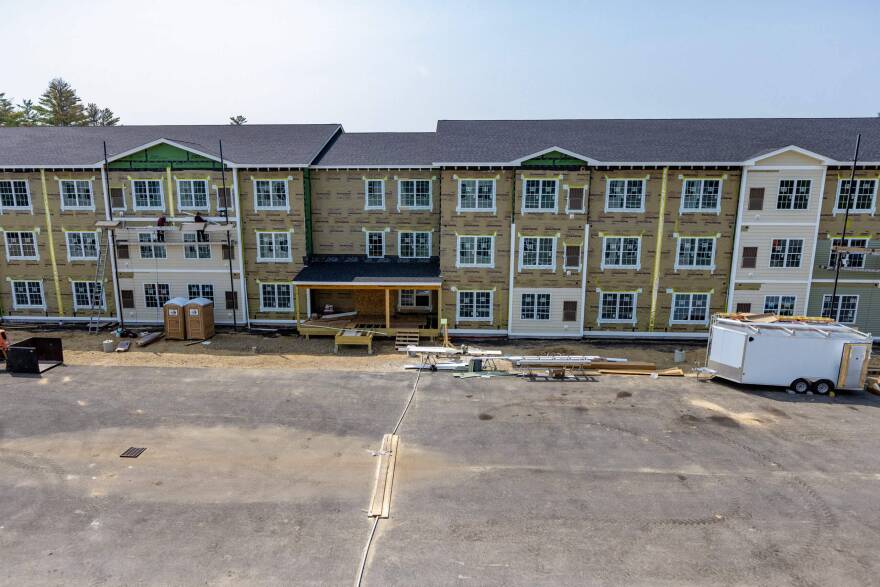In Massachusetts, housing advocates estimate developers need to build 100,000 more homes per year to keep up with demand. A low housing inventory has helped push the area’s rents and home prices to among the highest in the country, frustrating many residents. Real estate experts say the region must build more housing — and fast.
Part of the solution may come from factories. That is, manufacturing the modules that make up a building and then assembling them on construction sites. This can slash the time it takes to build new units.
The technique, known as offsite or modular construction, has gained traction in places like Sweden and Japan, as well as states like Pennsylvania and California, but it’s been slow to make inroads in New England.
Some developers argue it’s time to change that.
This method of construction was underway last month in Swanzey, New Hampshire, where a handful of carpenters were hammering off-white siding onto a brand new apartment complex. The plot of land had been empty in February. By May, the builders were close to finishing 84 affordable units.
“To go from zero building to 80% completion in two and a half months,” marveled Jack Franks, the CEO of Avanru Development Group, “this is a feat onto its own.”
Avanru, which built this complex, obtained most of the components from a factory in Pennsylvania. Imagine each apartment as a separate module — a big rectangular box, with frames, walls and bathrooms pre-built and delivered on a tractor trailer.
“The installation process is pretty neat,” Franks said. “We have a significantly good-sized crane that will set these into place like Legos.”
Volumetric Building Companies, a modular construction company with a design office in Somerville, operates the factory that made these “Legos.”
Vice President of Design Sara-Ann Logan said she’s seen more interest in this type of construction over the past year.
“It’s a game changer,” said Logan. “It is getting more expensive to build traditionally.”
Logan said improved technology is another reason builders may be exploring modular construction. She also thinks the increased interest stems from challenges in traditional construction, which only worsened after the pandemic.
“We don’t have the workforce to build traditionally anymore,” Logan said. “There’s a whole bunch of things that are going on in the world right now that are making it easier and make me think this is the time [for factory-made housing].”
According to the trade group Associated Builders and Contractors, the U.S. is short 546,000 construction workers.
Still, manufactured construction isn’t popular in Massachusetts. Logan estimates it makes up only about 2% of all new construction in the state. She thinks part of the reason it’s so limited is because developers in the area tend to be risk-averse.
“We have the universities, we have the people innovating, but we’re not really adopting it at the same rate as other states,” she said. “And that honestly makes me a little bit sad because I live here.”
Factory-made construction isn’t a new idea. Ivan Rupnik, who teaches architecture at Northeastern University, said the U.S. used to incorporate more manufacturing into construction.
“In the ’50s and ’60s, we actually built housing in the U.S. both on site and in factories using more advanced techniques than are widely used today,” he said.
According to Rupnik, a lot of construction in the U.S. today is slower and more expensive than it used to be. It’s also wasteful.
“We throw away about 50% of the materials that we that we bring to the construction site,” Rupnik said. “That alone is an economics problem.”
Manufactured housing does have challenges. In the past, critics have pointed to the subpar quality of some modular units. A 2018 WCVB investigation featured several Massachusetts residents who were frustrated by serious defects in their manufactured single-family homes. They blamed a lack of oversight and poor quality control in the building process.
It’s also expensive to build and maintain the factories required to make all the parts for this type of construction. The cost of labor and materials is often comparable to traditional construction. The savings, proponents argue, can be found in the condensed timeline.
Jack Franks, the developer in New Hampshire, pushed back against the notion that manufactured housing means lower quality.
“The quality of work here and the quality of workmanship is at, or better in some cases, than traditional stick built,” he said.
For Franks and other advocates, factory-made construction has the potential to transform housing. But they acknowledge it won’t solve all of New England’s housing woes. The region’s shortages are rooted in restrictive zoning and slow, laborious permitting processes.
Franks is hoping that as soon as projects are approved, buildings can go up in half the time. He even plans to build his own factory in New Hampshire where his company will focus on producing the components for energy-efficient modular buildings. The price tag for the factory, he estimates, is roughly $60 million.
“I’m all in,” Franks said. “I’m sitting at the poker table and I’m all in.”
Correction: Volumetric Building Companies’ factory is in Pennsylvania, but not in Philadelphia where the company is headquartered. We regret the error.
This article was originally published on WBUR.org.
Copyright 2023 WBUR. To see more, visit WBUR.




